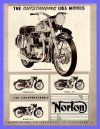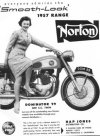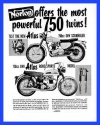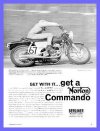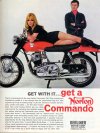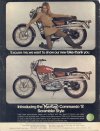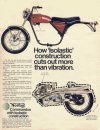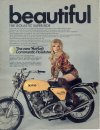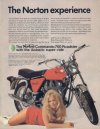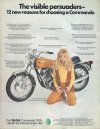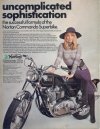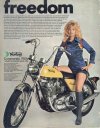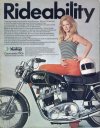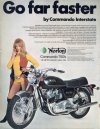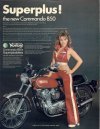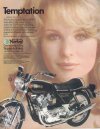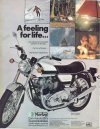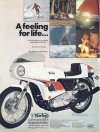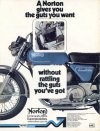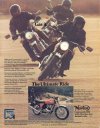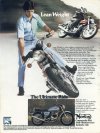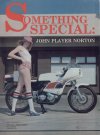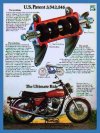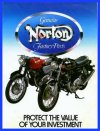 James Norton was very respected for his superb engineering ability and his integrity. An entrepreneur at the beginning of the motorized transportation era, he began the Norton Manufacturing Company in 1898 to produce bicycle parts. In 1902, the first Norton Motorcycle was built.
James Norton was very respected for his superb engineering ability and his integrity. An entrepreneur at the beginning of the motorized transportation era, he began the Norton Manufacturing Company in 1898 to produce bicycle parts. In 1902, the first Norton Motorcycle was built.
Five years later, a Norton ridden by Rembrandt Fowler won the first Tourist Trophy (TT). 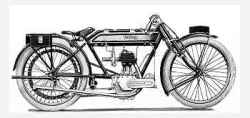 The Norton dominated the Isle of Man races from 1947-54. Known for performance, the motorcycle enjoyed worldwide demand. In the 1960's and 70's, the company produced the popular Norton Commando. The era of the vintage Norton motorcycle ended about 1977 with the demise of the British motorcycle industry. There have been attempts at revival and currently a motorcycle is being made under the marquee Norton.
The Norton dominated the Isle of Man races from 1947-54. Known for performance, the motorcycle enjoyed worldwide demand. In the 1960's and 70's, the company produced the popular Norton Commando. The era of the vintage Norton motorcycle ended about 1977 with the demise of the British motorcycle industry. There have been attempts at revival and currently a motorcycle is being made under the marquee Norton.
Now days, the Norton motorcycle is familiar to many motorcyclists. Motorcycle restoration enthusiasts world wide seek vintage Nortons. They bring a respectable price in antique motorcycle trading circles. This site is the future home of the Norton Motorcycle Owners Forum.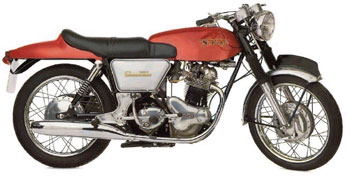
"Most motorcyclists love to spend their Sunday mornings taking off the cylinder head and re-seating the valves." Donald Heather, director of Norton, 1957.
Norton Motorcycle Magazine Ads. Click on an image to see the larger image.
The British motorcycle industry has a long and storied history, dating back to the late 19th and early 20th centuries. Although there were many notable British motorcycle manufacturers, Norton Motorcycle Company is one of the most iconic and has played a significant role in shaping the industry.
In the early days of the British motorcycle industry, pioneers such as George Brough and William R. Morris began experimenting with motorized bicycles, which ultimately led to the development of the first motorcycles. The industry took off in the 1900s, with the establishment of several manufacturers like Triumph, BSA, AJS, Matchless, and of course, Norton.
James Lansdowne Norton founded the Norton Motorcycle Company in 1898 in Birmingham, England. Initially, the company focused on manufacturing and supplying bicycle parts, but by 1902, they produced their first motorcycle, powered by a Clement engine. Over the following years, Norton began developing their own engines, and in 1907, they launched the first Norton motorcycle powered by their own single-cylinder engine.
Throughout the 1920s and 1930s, Norton achieved considerable racing success with their motorcycles, which helped establish their reputation for performance and reliability. Their "CamShaft One" (CS1) and "International" models were particularly successful in competitions like the Isle of Man TT, with riders like Jimmie Guthrie and Stanley Woods contributing to the brand's legendary status.
During World War II, Norton played a crucial role in supporting the British military by producing the 16H, a 490cc side-valve single, and the Big Four, a 633cc side-valve single. These motorcycles were designed to be durable and reliable, making them ideal for military use.
In the post-war era, Norton continued to innovate and expand their product line. The company introduced the Dominator, a parallel-twin engine motorcycle, in 1949. The Dominator would go on to become one of Norton's most successful and long-lasting models, with various iterations being produced until the 1970s.
The 1960s saw Norton achieving further racing success, most notably with the development of the Norton Manx, a single-cylinder racing motorcycle. The Manx was highly successful in the hands of riders like Geoff Duke and John Surtees, contributing to Norton's reputation as a dominant force in racing.
Despite its successes, Norton, like many other British motorcycle manufacturers, faced significant challenges in the 1960s and 1970s due to increased competition from Japanese manufacturers like Honda, Yamaha, and Suzuki. Financial difficulties and various ownership changes plagued the company, eventually leading to its collapse in 1976.
However, the Norton brand has been revived multiple times since then, with various attempts to restore the company to its former glory. In 2008, Norton Motorcycles was acquired by UK businessman Stuart Garner, who began producing new models, including the Commando 961 and the Dominator, paying homage to Norton's classic designs.
The British motorcycle industry has seen its ups and downs, but the Norton Motorcycle Company remains a symbol of British engineering and innovation. Although the company has faced numerous challenges over the years, the Norton brand continues to be cherished by motorcycle enthusiasts worldwide.
The Norton Motorcycle has a rich history in motorcycle racing, beginning in the early 20th century and continuing throughout much of the brand's existence. The company has achieved numerous race victories and set records, particularly in the Isle of Man TT, one of the most prestigious motorcycle races in the world. Here is an overview of Norton's racing history and notable achievements:
-
Early Racing Success (1907-1920s) Norton first entered the Isle of Man TT in 1907, and while they did not achieve immediate success, the experience provided valuable insights into motorcycle development. In 1909, Norton won their first Isle of Man TT race with rider Rem Fowler in the twin-cylinder class. This victory marked the beginning of Norton's racing legacy.
-
The 1930s – A Golden Era Norton's racing success truly took off in the 1930s, as their machines consistently dominated the Isle of Man TT. The introduction of the "CamShaft One" (CS1) and "International" models contributed to their success. During this period, Norton won numerous Senior TT and Junior TT races with legendary riders such as Jimmie Guthrie and Stanley Woods.
-
Post-War Success (1940s-1950s) After World War II, Norton continued to dominate in racing with models like the Manx, a single-cylinder racing motorcycle specifically designed for the purpose. The Norton Manx was exceptionally successful in the hands of riders like Geoff Duke, who won several Isle of Man TT races in the 1950s.
-
The 1960s – Continued Racing Achievements In the 1960s, Norton maintained its strong presence in racing, particularly with the Manx. Riders like John Surtees and Mike Hailwood contributed to the company's success. The Norton Manx's final victory in the Isle of Man TT came in 1961, in the hands of Mike Hailwood.
-
Decline and Revival (1970s-Present) The 1970s marked the beginning of a decline in Norton's racing success, coinciding with the company's financial troubles and increased competition from Japanese manufacturers. However, the Norton name has been associated with racing efforts in recent years, following the brand's revival by Stuart Garner. In 2009, Norton made a return to the Isle of Man TT with the new Norton NRV588, a rotary-powered race bike, though it did not achieve significant success.
In conclusion, Norton Motorcycles has a storied history in motorcycle racing, with numerous race victories and records. While the brand has experienced challenges and periods of decline, its racing legacy remains an important part of the Norton story and an inspiration for future endeavors.
Taking care of and maintaining a Norton Motorcycle is crucial for ensuring its longevity, performance, and reliability. Here are some key aspects of proper maintenance and care for this classic British motorcycle:
-
Regular Oil Changes: Change the engine oil and filter every 1,500 to 2,000 miles or as recommended in the owner's manual. Use high-quality motorcycle-specific oil and a compatible filter. Don't forget to check the oil level regularly and top up if necessary.
-
Valve Clearance: Check and adjust the valve clearance as per the manufacturer's recommended intervals. Proper valve clearance is essential for efficient engine performance and avoiding unnecessary wear on engine components.
-
Ignition System: Inspect the points and ignition timing regularly. Replace the points and condenser when they show signs of wear or corrosion. Ensure the spark plugs are clean, properly gapped, and replaced when necessary.
-
Carburetor: Clean and synchronize the carburetors as needed. Check for any signs of fuel leaks, and ensure that the idle and mixture settings are properly adjusted according to the manufacturer's specifications.
-
Chain and Sprockets: Lubricate the drive chain every 300-500 miles and check for proper tension. Inspect the sprockets for wear and replace them along with the chain when needed.
-
Brakes: Regularly inspect the brake pads or shoes for wear and replace them when necessary. Also, check the brake fluid levels and replace the fluid every 1-2 years or as specified by the manufacturer.
-
Tires: Check tire pressure regularly and maintain the recommended levels. Inspect tires for signs of wear, damage, or cracking, and replace them when needed. Keep in mind that tires have a limited lifespan, even if the tread appears to be in good condition.
-
Suspension: Inspect the forks and rear shocks for any leaks, damage, or signs of wear. Replace fork oil and seals as recommended in the owner's manual. Ensure that the rear suspension is properly adjusted for your weight and riding preferences.
-
Electrical System: Check the battery for proper fluid levels, corrosion, and clean connections. Inspect wiring, switches, and connectors for wear or damage, and replace any faulty components.
-
General Maintenance: Keep the motorcycle clean and protected from the elements, and regularly inspect the frame, fasteners, and cables for any signs of wear or damage. Periodically grease or lubricate bearings, pivots, and other moving parts as needed.
By following these maintenance and care tips, you can help ensure that your Norton Commando 750 remains a reliable and enjoyable classic motorcycle for years to come. Always refer to the owner's manual for specific maintenance intervals and procedures, and consult a professional mechanic if you're unsure about any aspect of your motorcycle's care.
Norton Motorcycle Company has been a significant player in the motorcycle industry since its inception, achieving numerous accomplishments in terms of engineering, design, and racing.
Norton was at the forefront of motorcycle design in the early 20th century, producing innovative models like the Big 4, Model 18, and International, which featured advanced technologies and superior engineering for their time.
-
Introduction of the Featherbed Frame: In 1950, Norton introduced the revolutionary Featherbed frame, designed by the McCandless brothers. This frame became an industry standard for handling and stability, allowing riders to push their bikes to the limit on the racetrack.
-
Racing Success: Norton achieved significant success in motorcycle racing, particularly in the prestigious Isle of Man TT. From their first victory in 1909 to their dominance in the 1930s, 1940s, and 1950s, Norton Motorcycles became synonymous with racing prowess. Norton's racing machines, such as the Manx, International, and Dominator, were highly successful and contributed to the brand's legendary status.
-
Military Service: During World War II, Norton played an essential role in supporting the British military by producing reliable and durable motorcycles like the 16H and the Big Four. These bikes were widely used by British and Commonwealth forces throughout the conflict.
-
The Norton Commando: Launched in 1967, the Norton Commando was a highly successful model that showcased the brand's innovative spirit. The Commando featured the "Isolastic" frame, which significantly reduced engine vibrations, and the model received numerous awards, including "Machine of the Year" for five consecutive years (1968-1972) from the British publication Motor Cycle News.
-
Iconic Brand and Global Presence: Norton Motorcycle Company is one of the most iconic British motorcycle brands, with a global presence and recognition that extends far beyond the UK. The brand's history, design innovations, and racing achievements have earned Norton a special place in the hearts of motorcycle enthusiasts worldwide.
-
Brand Revival and Modern Models: Despite facing financial difficulties and ownership changes throughout the years, the Norton brand has been revived multiple times. Under the leadership of Stuart Garner in 2008, Norton began producing new models like the Commando 961 and the Dominator, blending classic design elements with modern engineering and technology.
These accomplishments demonstrate the impact Norton Motorcycle Company has had on the motorcycle industry and the brand's enduring legacy. Norton's innovations, racing success, and iconic designs have made it a significant part of motorcycling history and continue to inspire future generations of riders and enthusiasts.

